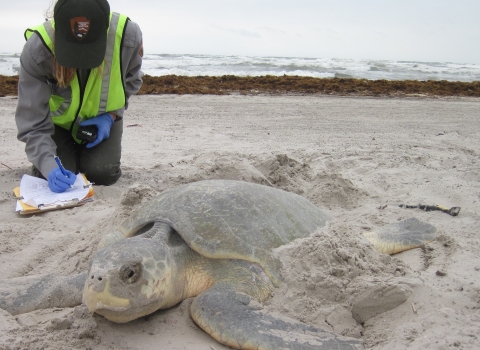The U.S. Fish and Wildlife Service has completed initial reviews on petitions to list four species and downlist one species under the Endangered Species Act (ESA). The Service has determined that petitions to list the American bumble bee, Long Valley speckled dace, and Siuslaw hairy-necked tiger beetle contain substantial information that listing may be warranted. Rigorous status reviews will be initiated on these species.
The petitions to downlist the Florida torreya and list the Tucson shovel-nosed snake as threatened or endangered were found to not have substantial information indicating the petitioned action is warranted.
The American bumble bee is a large yellow and black insect found across most of the continental U.S. and in some areas of Canada and Mexico. Within that wide range, the pollinator is a common visitor to backyards, farm field, and wild landscapes. The species is potentially threatened by disease, habitat destruction, livestock grazing, pesticide use, loss of genetic diversity, climate change climate change
Climate change includes both global warming driven by human-induced emissions of greenhouse gases and the resulting large-scale shifts in weather patterns. Though there have been previous periods of climatic change, since the mid-20th century humans have had an unprecedented impact on Earth's climate system and caused change on a global scale.
Learn more about climate change and competition from non-native honeybees.
The Siuslaw hairy-necked tiger beetle is a stocky yet tiny insect found on some beaches along the Pacific coast. The predator inhabits the sandy edges of freshwater streams and outflows that meet the sea. Potential threats to the species include off-highway vehicle activity, invasive species invasive species
An invasive species is any plant or animal that has spread or been introduced into a new area where they are, or could, cause harm to the environment, economy, or human, animal, or plant health. Their unwelcome presence can destroy ecosystems and cost millions of dollars.
Learn more about invasive species , bulldozing, dredge soil and sand deposition, sea level rise, flooding and coastal erosion.
The Long Valley speckled dace is a fish found only in California. A resident of freshwater systems in high elevation deserts, they can occupy streams flowing from hot springs. Potential threats to the Long Valley speckled dace are associated with geothermal development, habitat alteration, livestock grazing, disease, predation, invasive species and climate change. The petition requested several actions for two other speckled dace entities, however, they did not qualify.
The Florida torreya, also known as Florida nutmeg, is a tree found in northern Florida and southern Georgia. The petition requesting the species be downlisted to threatened presented information regarding the species’ range, impacts of disease, propagation best practices, and locations of historical plantings. The Service assessed the extent to which the threats currently impacting the Florida torreya have been reduced or removed since the species was listed under the ESA. Based on a review of the petition, sources cited in the petition, and other information, the Service does not find that the petitioned action may be warranted.
The Tucson shovel-nosed snake is a small, banded reptile found in the deserts of Arizona. In December 2004, the Center for Biological Diversity requested the species be listed as a threatened or endangered species and that critical habitat be designated under the ESA. After completing a substantial 90-day finding, a Species Status Assessment in 2014, and a 12-month finding, the Service concluded listing was not warranted. In September 2020, the Service received a petition requesting the same actions from the same petitioner. In response to the most recent petition, the Service finds the petition does not present substantial information indicating that listing the species may be warranted.
The ESA allows citizens to petition the Service to add species to the ESA list, remove species from the list, and to reclassify species already on the list. To the maximum extent possible, the Service issues a finding on a petition within 90 days of the petition’s receipt.
Substantial 90-day findings represent a relatively low bar, requiring only that the petitioner provide information that the proposed action may be warranted. The next steps involve in-depth status reviews and analyses using the best available science and information to arrive at a 12-month finding. The public can play an important role by sharing relevant information with the Service.
The Federal Register docket numbers and links for the substantial petition findings in this batch are:
| Species | Range | Docket Number | Docket link |
| Long Valley speckled dace | CA | FWS–R8–ES–2021–0065 | https://www.regulations.gov/docket/FWS-R8-ES-2021-0065 |
| Tucson shovel-nosed snake | AZ | FWS–R2–ES–2021–0067 | https://www.regulations.gov/docket/FWS-R2-ES-2021-0067 |
| American bumble bee | AL, AZ, AR, CA, CO, DE, FL, GA, IL, IN, IA, KS, KY, LA, MD, MI, MS, MO, MT, NE, NV, NJ, NM, NY, NC, OH, OK, OR, PA, SC, SD, TN, TX, VA, WV; Canada (ON); Mexico | FWS–R3–ES–2021–0063 | https://www.regulations.gov/docket/FWS-R3-ES-2021-0063 |
| Florida torreya | FL, GA | FWS–R4–ES–2021–0064 | https://www.regulations.gov/docket/FWS-R4-ES-2021-0064 |
| Siuslaw hairy-necked tiger beetle | CA, OR, WA | FWS–R1–ES–2021–0066 | https://www.regulations.gov/docket/FWS-R1-ES-2021-0066 |
For more information on the ESA listing process, including 90-day findings and status reviews, please go to www.fws.gov/endangered/esa-library/pdf/listing.pdf.The notice for the above findings will be available in the Federal Register Reading Room on September 28, 2021 at https://www.federalregister.gov/public-inspection on the 2021 Notices link under Endangered and Threatened Wildlife and Plants.



